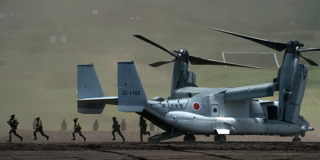While Japan’s move toward rearmament is welcome, the embrace of Tomahawk missiles and hypersonic weapons alone will not force China to stop waging hybrid warfare. Japan must also find ways to frustrate China’s furtive efforts to alter the regional status quo while avoiding the risk of open combat.
TOKYO – For decades, Japan has based its international clout on economic competitiveness, not military might. But, with China’s lengthening shadow darkening its doorstep, Japan now seems to be abandoning its pacifist postwar security policy – which capped defense spending at about 1% of GDP and shunned offensive capabilities – in favor of assuming a central role in maintaining security in the Indo-Pacific region.
Last month, Japan unveiled a bold new national-security strategy, which includes a plan to double defense expenditure within five years. That spending – amounting to some $320 billion – will fund Japan’s largest military build-up since World War II, and implies the world’s third-largest defense budget, after the US and China. Importantly, the new strategy includes acquisition of preemptive counterstrike capabilities, such as Tomahawk cruise missiles from the United States, and the development of its own hypersonic weapons.
Japan began laying the groundwork for this shift under former Prime Minister Abe Shinzō, who was assassinated last July. On Abe’s watch, Japan increased defense spending by about 10%, and, more significantly, reinterpreted (with parliament’s approval) the country’s US-imposed “peace constitution” to allow the military to mobilize overseas for the first time since WWII. Abe also sought to amend Article 9 of the constitution, which renounces “the threat or use of force” by Japan, but his efforts were stymied by popular protests.

TOKYO – For decades, Japan has based its international clout on economic competitiveness, not military might. But, with China’s lengthening shadow darkening its doorstep, Japan now seems to be abandoning its pacifist postwar security policy – which capped defense spending at about 1% of GDP and shunned offensive capabilities – in favor of assuming a central role in maintaining security in the Indo-Pacific region.
Last month, Japan unveiled a bold new national-security strategy, which includes a plan to double defense expenditure within five years. That spending – amounting to some $320 billion – will fund Japan’s largest military build-up since World War II, and implies the world’s third-largest defense budget, after the US and China. Importantly, the new strategy includes acquisition of preemptive counterstrike capabilities, such as Tomahawk cruise missiles from the United States, and the development of its own hypersonic weapons.
Japan began laying the groundwork for this shift under former Prime Minister Abe Shinzō, who was assassinated last July. On Abe’s watch, Japan increased defense spending by about 10%, and, more significantly, reinterpreted (with parliament’s approval) the country’s US-imposed “peace constitution” to allow the military to mobilize overseas for the first time since WWII. Abe also sought to amend Article 9 of the constitution, which renounces “the threat or use of force” by Japan, but his efforts were stymied by popular protests.